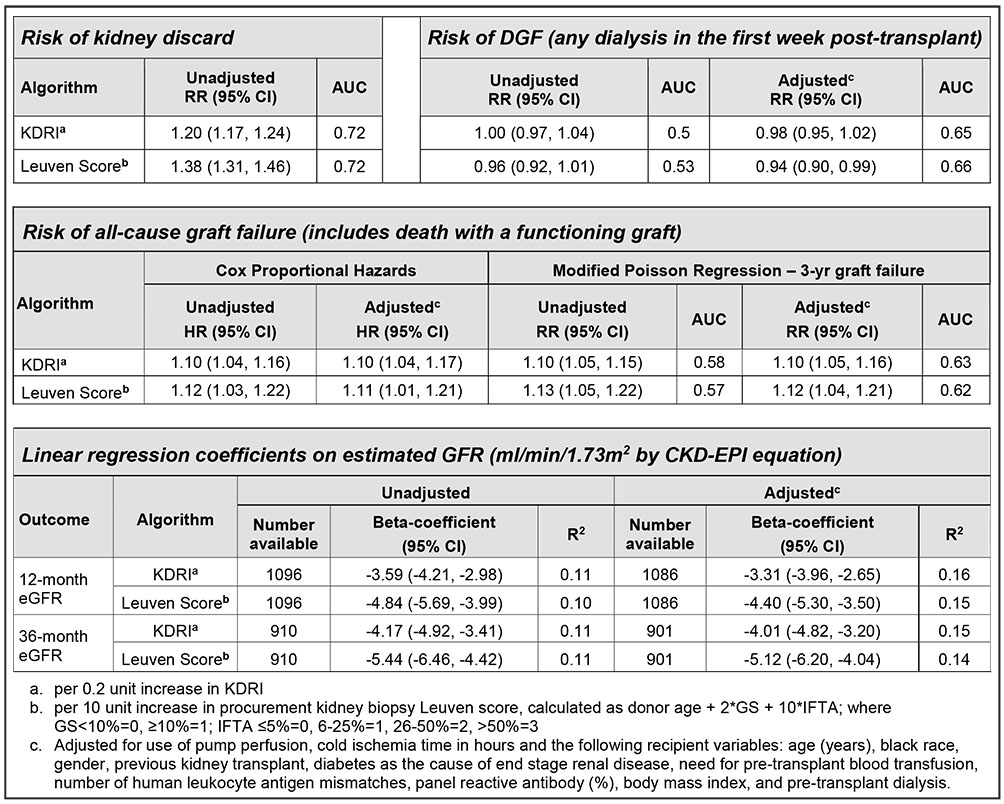Procurement Kidney Biopsy versus KDRI for Predicting Graft Survival.
1University of Utah, Salt Lake City, UT
2Yale University, New Haven, CT
3University Hospital, Ulm, Germany
4Saint Barnabas Medical Center, Livingston, NJ
5University of Pennsylvania, Philadelphia, PA
6Wayne State University, Detroit, MI
Meeting: 2017 American Transplant Congress
Abstract number: 434
Keywords: Biopsy, Graft failure, Graft function, Kidney transplantation
Session Information
Session Name: Concurrent Session: Kidney Optimizing Donor/Recipient Selection and Matching
Session Type: Concurrent Session
Date: Tuesday, May 2, 2017
Session Time: 2:30pm-4:00pm
 Presentation Time: 2:54pm-3:06pm
Presentation Time: 2:54pm-3:06pm
Location: E450a
Background: The kidney donor risk index (KDRI) incorporates 10 variables to match organ quality with expected recipient survival. Though controversial, procurement biopsies are often performed for high-risk kidneys. The Leuven score combines donor age, glomerulosclerosis (GS) and interstitial fibrosis/tubular atrophy (IFTA) to predict graft survival. We compared procurement kidney biopsy Leuven scores to KDRI for predicting transplant outcomes.
Methods: In this multicenter study, we calculated KDRI and Leuven scores from biopsy reports (frozen wedge sections read at donor hospitals from 2010-2013) to determine associations with kidney discard, 3-yr graft failure, delayed graft function (DGF) and 12 and 36-month estimated GFR. We used Cox, modified Poisson, and linear regression to calculate risks based on KDRI and (separately) Leuven scores, adjusting for pump perfusion, ischemia time and 10 recipient variables, including age and diabetes. We also calculated areas under receiver-operating characteristic curves (AUCs).
Results: From 887 donors, 1699 kidneys were procured and biopsied. Median [IQR] donor age was 53 [44-61] yrs, 15% donated after cardiac death, KDRI was 1.57 [1.29-1.91] and Leuven score was 59 [49-69]. 585 (34%) kidneys were discarded. Relative risk (95% CI) for discard was 1.20 (1.17-1.24) per 0.2 unit increase in KDRI and 1.38 (1.31-1.46) per 10 unit increase in Leuven score. Unadjusted and adjusted hazard ratios, relative risks, AUCs and linear regression coefficients were similar for both scores as shown below.
Conclusions: In kidneys selected for procurement biopsy, the Leuven score was more strongly associated with discard but performed similarly to KDRI for predicting transplant outcomes. Adjusted associations were modest, however, suggesting neither KDRI nor the Leuven score should be used for individual organ acceptance decisions.
CITATION INFORMATION: Hall I, Parikh C, Schröppel B, Weng F, Jia Y, Thiessen-Philbrook H, Reese P, Doshi M. Procurement Kidney Biopsy versus KDRI for Predicting Graft Survival. Am J Transplant. 2017;17 (suppl 3).
To cite this abstract in AMA style:
Hall I, Parikh C, Schröppel B, Weng F, Jia Y, Thiessen-Philbrook H, Reese P, Doshi M. Procurement Kidney Biopsy versus KDRI for Predicting Graft Survival. [abstract]. Am J Transplant. 2017; 17 (suppl 3). https://atcmeetingabstracts.com/abstract/procurement-kidney-biopsy-versus-kdri-for-predicting-graft-survival/. Accessed December 24, 2025.« Back to 2017 American Transplant Congress
